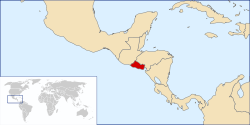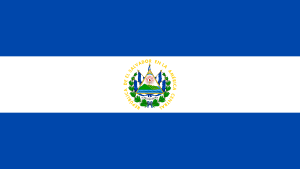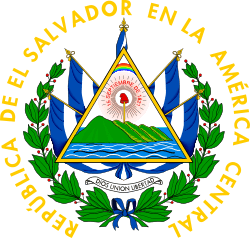Revolutionary Government Junta of El Salvador
The Revolutionary Government Junta (Spanish: Junta Revolucionaria de Gobierno, JRG) was the name of three consecutive military dictatorships that ruled El Salvador between October 15, 1979 and May 2, 1982. The first junta from 1979 to 1980 contained two colonels, Adolfo Arnoldo Majano Ramos and Jaime Abdul Gutiérrez Avendaño, and three civilians, Guillermo Ungo, Mario Antonio Andino and Román Mayorga Quirós. The second junta from January through December 1980 consisted of Gutiérrez, Majano, José Antonio Morales Erlich, Héctor Dada Hirezi, and José Ramón Ávalos Navarrete. The final junta from 1980-1982 consisted of Gutiérrez, Morales, Ávalos, with José Napoleón Duarte as the junta's president. During their reigns, the Revolutionary Government Juntas were the source of mass murder, torture, executions and unexplained disappearances.
Revolutionary Government Junta Junta Revolucionaria de Gobierno | |||||||||
|---|---|---|---|---|---|---|---|---|---|
| 1979–1982 | |||||||||
 | |||||||||
| Capital | San Salvador | ||||||||
| Common languages | Spanish | ||||||||
| Government | Military dictatorship | ||||||||
| Legislature | First Revolutionary Government Junta (1979–1980) Second Revolutionary Government Junta (1980) Third Revolutionary Government Junta (1980–1982) | ||||||||
| Historical era | Cold War – Salvadoran Civil War | ||||||||
| October 15 1979 | |||||||||
| March 3 1982 | |||||||||
| Currency | Salvadoran colón | ||||||||
| ISO 3166 code | SV | ||||||||
| |||||||||
Coup and First Junta
On October 15, 1979, young military officers staged a coup, which overthrew President Carlos Humberto Romero, ending 17 years of National Coalition Party rule over El Salvador. President Romero faced growing unrest in his country and had a threat of a revolution. Mass organizations had practically occupied the streets and were confronted with direct attacks by the National Guard and the Army. The guerrilla groups acted in the city and in the countryside with increasing development, and dedicated themselves not only to the fight against the security forces, but also to the extermination of the members of the Nationalist Democratic Organization (ORDEN), a political group created by the government in the early 1960s, which at that time was fulfilling paramilitary tasks or denouncing militants on the left. From a year earlier, the Inter-American Commission on Human Rights (IACHR) of the Organization of American States (OAS) prepared a condemnatory report of Romero's government which was to be presented at a meeting to be held on October 22, 1979 in La Paz, Bolivia. In the previous months, US president Jimmy Carter sent undersecretary of state Viron P. Vakyl to meet Romero to warn him that he should resign or call early elections, preferably in 1980.
The leaders of the 1979 coup had the support of the government of the United States, which believed that President Romero had lost control of the situation in the country and showed concern about the strengthening of the armed groups of the left. After several months of conspiracies and negotiations within the army, the armed forces endorsed the coup.
The coup was endorsed by the so-called Popular Forum which was composed of some organizations currently fighting in the streets such as the National Federation of Salvadoran Workers' Unions (FENASTRAS), which was the most powerful central union belonging to the Unified Popular Action Front (FAPU), and the Popular Leagues "February 28" (LP-28). It was also supported by the Salvadoran Communist Party, the Nationalist Democratic Union, and several union groups. More support came from the Christian Democratic Party (PDC), the Social Democratic National Revolutionary Movement (MNR) and the Central American Unionist Party (PUCA).
.gif)
After intense and rapid negotiations between the military, the Popular Forum, and members of the Chamber of Commerce and Industry of El Salvador (CCIES), the first Revolutionary Government Junta of El Salvador (JRG), or First Junta, consisting of two military officers and three civilians, was formed.
The military was represented by Colonels Jaime Abdul Gutiérrez Avendaño and Adolfo Arnoldo Majano Ramos. The three civilians were Román Mayorga Quiroz, a professor at the Central American University of José Simeón Cañas, Mario Antonio Andino Gómez, the former vice president of the Chamber of Commerce and Industry of El Salvador (CCIES), and Guillermo Manuel Ungo, the president of the National Revolutionary Movement (MNR).
The coup leaders presented a centrist government program and promised a series of social reforms such as land reforms and the nationalization of banking and coffee trade. It also promised the cessation of violence by security forces against the civilian population and the implementation of a true democratic system in the country. A cabinet of ministers was appointed in which former opponents of the PCN governments participated, among them, the Democrat Rubén Zamora as Minister of the Presidency and businessman Enrique Álvarez Córdoba as Minister of Agriculture but also had representatives of the conservative sector of the country such as Colonel José Guillermo García who was Minister of Defense.
The Archbishop of San Salvador, Monsignor Óscar Arnulfo Romero, who had denounced the human rights abuses of General Romero's government, publicly expressed his hope in the good intentions of the new government. On the contrary, leftist groups increased protests and strikes throughout the country and refused to dialogue with the new government.
Attention was drawn to the absence of the Christian Democratic Party in the junta, the traditionally strongest organization of the Salvadoran opposition. This was due to a maneuver of the MNR and the PCS in the Popular Forum which prevented the arrival of a Christian Democratic leader with power or with influence that neutralized the other civilian members such as José Napoleón Duarte, Adolfo Rey Prendes, or José Antonio Morales Erlich. However, the PDC did not plan to "spend" on its strong pieces, and sent junta young members of the progressive sector, such as Mario Zamora, Rubén Zamora, Héctor Dada Hirezi, and Jorge Villacorta, who obtained key positions such as the Ministry of the Presidency and other key ministries.
The presence of Mayorga, Ungo, and the PDC progressives, as well as figures linked to the left-wing Jesuits, put private companies on guard which did not support their representative. The traditionalist military, temporarily retracted, was also put on guard. Disputes immediately began between civilian and military representatives in the junta. It was clear that the alliance would not last long and the army began parallel conversations with the traditional members of the PDC.
Although it was expected that the coup d'etat and the conformation of the junta would slow down the popular protests, things got worse. Although the communist party gave "critical support" to the government and several of its most prominent militants occupied ministries, vice-ministries, and offices, the FAPU began fighting in the streets together with the Popular Revolutionary Bloc to demand a petition sheet, very similar to the one proposed by the Armed Forces, as part of its government plan: salary increases, agrarian reform, dissolution of ORDER, rental freezes, upon many more demands. As if that were not enough, the LP-28 made shots of peripheral populations, supported by the People's Revolutionary Army, and called for insurrection; they were fought off by the security forces, with significant casualties between their militants and the civilian population. The repression against the left did not cease since numerous officers of the Armed Forces maintained ties of collaboration with death squads (far-right groups) under the new government. As during the presidency of General Romero, the death squads exerted considerable pressure on any junta official who attempted to implement the promised reform plan. Death squads acted with impunity, killing those suspected of being supporters of left-wing armed organizations and even members of the Christian Democratic Party despite the fact that the party supported the new government. Within the first week after the junta took power, human rights organizations reported a hundred deaths due to political violence.
On December 28, 1979 there was a meeting between members of the civil cabinet, the junta, and representatives of the different sectors of the army, which ended in a confrontation that led to the end of the first junta. The spiral of violence between the armed groups of the left, the death squads, and the security forces continued throughout November and December 1979; the country lived in a pre-war environment. Meanwhile, the internal contradictions within the junta soon became apparent, with Colonel Majano representing a progressive point of view while Colonel Gutiérrez represented the opinion of the conservative sectors of the Armed Forces. Between January 2 and 5, 1980, the three civilian members of the junta resigned. The cabinet of ministers, except the defense minister, Colonel García, also resigned. On January 2, Archbishop Oscar Arnulfo Romero held a mediation meeting which failed.
Second Junta
Within the PDC, a good part of the progressives had left the government with few remaining in their positions (such as attorney Mario Zamora). On January 9, 1980, the second Revolutionary Government Junta, or second junta, was formed.
In addition to Gutiérrez and Majano, José Antonio Morales Erlich, from the traditionalist sector of the PDC, Héctor Dada Hirezi, a progressive, and José Ramón Ávalos Navarrete, a doctor, joined the second junta.[1]
On January 22, the leftist groups created the Mass Revolutionary Coordinator in an effort for leftist unification. The extreme right began to accuse the new government of complacency towards the leftist forces. On February 23, a death squad killed the attorney general of the poor, Mario Zamora Rivas, a prominent member of the PDC.[2]
On March 3, Héctor Dada Hirezi resigned from his position within the junta. The leader of the PDC, José Napoleón Duarte, replaced him. Hirezi went into exile and lived in Mexico for 12 years.[3]
On March 8, 1980, the junta approved the expected laws of agrarian reform and bank nationalization.[4] On March 24 around 5pm, a death squad on orders of Roberto D'Aubuisson murdered Monsignor Óscar Romero. That same week, the President of the Junta, Colonel Adolfo Majano, gave press statements stating that Interpol had the list of suspects in Romero's murder and that he would give that report to the judge assigned to the case, the Fourth Judge of Criminal Atilio Ramírez Amaya.[5] The judge was nearly assassinated when armed men arrived to kill him at his residence. He responded to the attack with a firearm and managed to escape death. The Interpol list never came to the judge, nor was it granted special protection when asked to the then President of the Supreme Court of Justice. He had no choice but to go into exile to Costa Rica. Later, army officers loyal to Majano arrested Major D'Aubuisson during a meeting in which information allegedly related to the assassination of Monsignor was seized, within an agenda of Captain Álvaro Saravia, under the name of "Operation Pineapple."[6] However, Major D'Aubuisson was not tried for the murder, nor for treason, despite him saying that he wanted to coup the junta. He was released from prison in May 1980.
On April 17, the Mass Revolutionary Coordinator joined other left-wing political organizations to form the Revolutionary Democratic Front (FDR). In August 1980, there was a call for a general strike that was repressed by the army.
During the following months the violence overflowed in the country. The far-right groups continued to act without control. Many murders radicalized the left sectors that responded by accelerating their unification process. On October 10, the armed organizations of the left formed the Farabundo Martí National Liberation Front (FMLN).
In December 1980, Colonel Arnoldo Majano resigned from his position in the junta.
Third Junta and democratization
After the departure of Majano on December 13, 1980, the third Revolutionary Government Junta, or the third junta, was formed. It consisted of Colonel Jaime Abdul Gutiérrez Avendaño and three civilians: José Napoleón Duarte as the President of the Junta, Antonio Morales Ehrlich, and José Ramón Ávalos Navarrete. The government of the new junta continued the implementation of the agrarian reforms and promised democratization.[7] The United States continued economic aid to the junta sending over 150 million dollars.
The government managed to contain the January 1981 General Offensive, also known as the "final offensive", the first large-scale one launched by the newly founded FMLN on October 10, 1980. Although the offensive failed, the FMLN forces were not annihilated and mostly retreated to rural areas of the country. The FMLN dismantled its mass groups and strengthened its military structures, beginning a prolonged civil war, which would culminate with the Chapultepec Peace Accords, on January 16, 1992.
In March 1981, the junta announced that it would convene elections to elect a constituent assembly during the following year. President Duarte wanted a dialogue but not negotiations with the FDR. Meanwhile in the United States, 100,000 Americans protested in front of the Pentagon in opposition to the US involvement in El Salvador. In June 1981, the Salvadoran Association of Judges declined to participate in preparations for the 1982 elections due to continued state terror and state of siege.
The elections were held on March 28, 1982. The National Constituent Assembly took office on May 2, 1982, and Álvaro Magaña became President of El Salvador, ending the Revolutionary Government Junta of El Salvador.
References
- "La tormentosa fuga del juez Atilio". Retrieved January 25, 2020.
- "Mario Zamora: Three Decades". Retrieved January 25, 2020.
- "Entrevista con Héctor Dada Hirezi: "Éramos ilusos"". Retrieved January 25, 2020.
- Duarte, José Napoleón (1986). Duarte: My Story.
- "La tormentosa fuga del juez Atilio". Retrieved January 25, 2020.
- "Así matamos a monseñor Romero". Retrieved January 25, 2020.
- "Basic Law of Agrarian Reform". Archived from the original on February 11, 2009. Retrieved January 25, 2020.
| Political offices | ||
|---|---|---|
| Preceded by Carlos Humberto Romero |
Revolutionary Government Junta 1979–1982 |
Succeeded by Álvaro Magaña |

